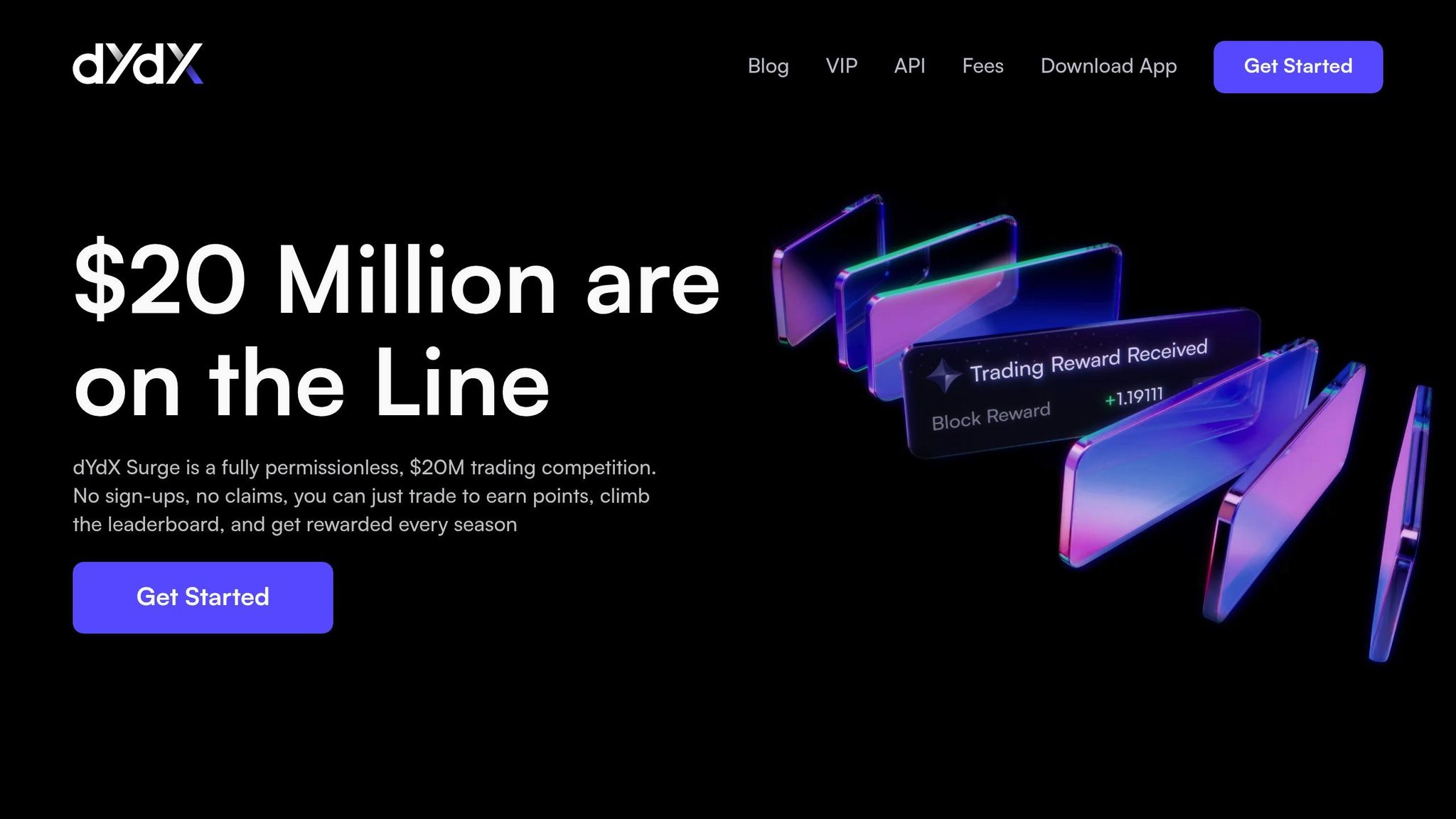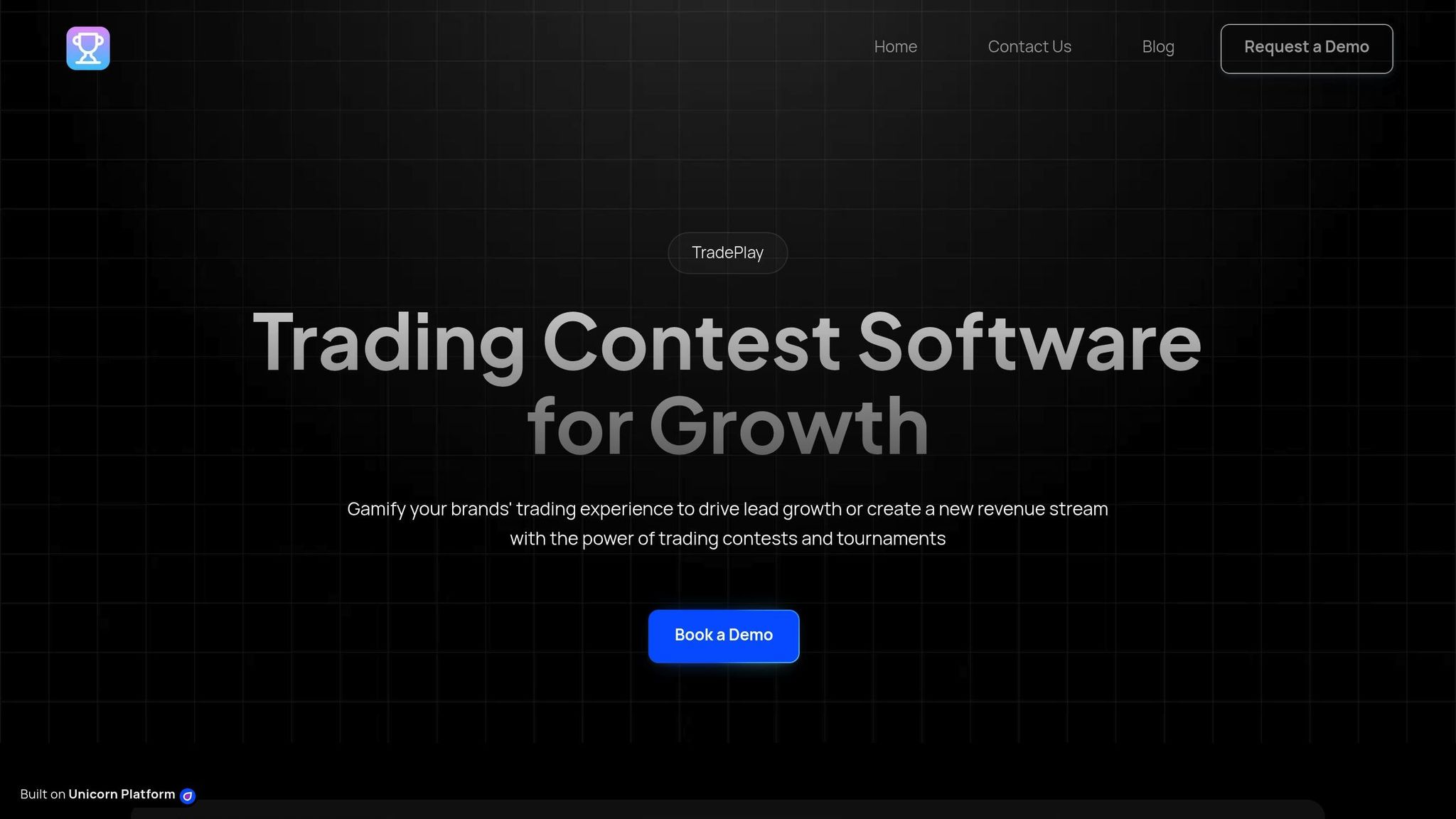- Motivate traders: Use percentile rankings (e.g., "Top 25%") instead of fixed positions to keep everyone motivated.
- Track performance: Include metrics like ROI, profit/loss, win rates, and trading volume for meaningful insights.
- Encourage growth: Offer tiered rewards for achievements like consistent trades or improved ROI.
- Protect privacy: Let users choose display names and opt out of public rankings.
- Boost engagement: Update leaderboards weekly or monthly, and send live notifications for progress.
Quick Tip:
Design smaller, regional leaderboards or group users by experience level to create fair competition and personalized challenges.
Ready to learn more? Let’s dive into why these strategies work and how to implement them effectively.
Introducing dYdX Surge – A $20M Trading Competition

Building Effective Leaderboards
Designing a leaderboard that is simple, fair, and engaging is key to boosting participation in trading contests. Studies show that traditional leaderboards often discourage users who fall outside the top 5-10% of rankings. To address this, modern designs should aim to keep all participants motivated, regardless of their rank.
Structure and Performance Metrics
Using percentile-based rankings can make standings feel more meaningful. For instance, showing a trader they’re in the top 25% is far more motivating than just listing them as "#156." This approach gives users a clearer sense of their performance within the larger group.
Metrics to include in a leaderboard:
- Return on Investment (ROI)
- Profit and Loss (P&L) in USD
- Win rate percentage
- Risk-adjusted returns
- Trading volume
"Instead of showing users their rank as a meaningless number, display their position as a percentile." - Yu-kai Chou
Updating leaderboards weekly or monthly can level the playing field. This ensures new participants have a fair chance to compete and prevents long-term leaders from dominating indefinitely.
Clear Data Display
The way data is presented matters. For U.S. markets, use consistent and easy-to-read formats:
| Metric Type | Format Example | Notes |
|---|---|---|
| Currency | $12,345.67 | Include cents for precision |
| Percentages | 15.75% | Use two decimal places |
| Dates | 05/05/2025 | MM/DD/YYYY format |
| Large Numbers | 1,234,567 | Add commas as thousand separators |
Including features like "neighborhood ranking" can also help. Showing users their current position alongside nearby competitors encourages small, achievable improvements rather than overwhelming them with a large gap to the top.
User Data Protection
Once the data is displayed clearly, protecting user privacy is essential. Here’s how you can safeguard sensitive information:
- Let users choose display names instead of real names.
- Provide an option to opt out of public ranking displays.
- Mask sensitive trading data while maintaining fairness.
- Group users regionally without revealing exact locations.
Creating smaller, customized leaderboards - based on criteria like account size, trading style, or experience level - can further enhance the experience. This allows traders to compete within relevant peer groups while maintaining privacy and ensuring fair competition.
Increasing User Participation
Encourage engagement by offering rewards and providing timely updates.
Rewards and Achievement Systems
Using a tiered rewards system can motivate traders across different experience levels. Here's how it works:
| Achievement Type | Reward Example | Trigger Condition |
|---|---|---|
| Trading Volume | Silver Badge | $100,000 traded |
| Consistency | Gold Star | 10 profitable trades in a row |
| Risk Management | Risk Master | Maintaining stop-loss on 95% of trades |
| Progress | Monthly Champion | 25% improvement in ROI |
"By learning how to create leaderboards that motivate the most significant number of users, we can enhance the overall experience and harness the full potential of this powerful gamification tool." - Yu-kai Chou
Regular updates on progress ensure users stay engaged and motivated to achieve these milestones.
Live Updates and Notifications
Instant feedback helps keep users involved. Some effective strategies include:
- Position Alerts: Let users know when they're close to reaching a higher percentile rank.
- Achievement Updates: Send congratulatory messages when new badges are earned.
- Daily Summaries: Share performance metrics at the end of the trading day (4:00 PM EST).
- Weekly Recaps: Highlight weekly performance every Friday after the market closes.
Keep these updates focused on actionable insights to avoid overwhelming users.
U.S. Market Standards
To engage U.S.-based traders effectively, real-time updates should align with market practices:
- Begin contests at 9:30 AM EST, matching the U.S. market opening.
- Calculate daily performance based on U.S. trading hours.
- Display all values in USD (e.g., $1,234.56) with proper formatting.
- Refresh regional rankings every 15 minutes during market hours.
Regional micro-leaderboards allow U.S. traders to compete within their time zone while still accessing global rankings. Update regional standings every 15 minutes and global rankings at the end of each trading day.
sbb-itb-cad9573
Technical Implementation
Build a reliable leaderboard system by carefully designing its architecture and ensuring smooth integration with trading platforms.
Platform Integration
To keep everything running smoothly across various trading platforms, rely on stable API connections for frequent data updates.
Here’s a breakdown of the key components:
| Component | Purpose | Implementation Approach |
|---|---|---|
| Data Sync | Real-time updates | Use a Data PUSH API paired with live database syncing. |
| Storage Solution | Manage leaderboard data | Implement Redis Sorted Sets for efficient O(log(n)) operations. |
| Performance Buffer | Reduce server load | Use an in-memory local buffer that aggregates updates every minute. |
| Platform Support | Ensure compatibility | Build REST APIs for MT4, MT5, and DXTrade integration. |
The in-memory buffer plays a crucial role by collecting updates before pushing them to the database. This approach ensures stability, even during high traffic.
"Efficient and scalable program that dynamically updates the leader-board with the latest ranking every minute, ensuring accuracy and performance even under high trading activity." - pratikdaigavane, GitHub
These methods lay the groundwork for TradePlay's advanced contest features.
TradePlay Features

TradePlay’s contest system is designed to handle everything from batch processing to near real-time data streaming, meeting the demands of various trading contests. The system uses serverless functions that scale automatically during peak trading activity, keeping performance consistent.
Key implementations include:
- Geo-replication across multiple data centers for reliability
- Asynchronous write-behind cache patterns to optimize database performance
- Database triggers to enable real-time notifications
- Cross-region cache servers for fast, low-latency access
By using Dragonfly as the caching solution, TradePlay achieves 25X faster performance at 80% lower costs compared to Redis. Even during high-volume trading, the system maintains response times under 50 milliseconds.
These features ensure TradePlay delivers a competitive and stable environment for trading contests.
Performance Tracking and Updates
Success Metrics
| Metric Category | Key Indicators | Notes |
|---|---|---|
| Trading Performance | Profit Factor, Win Ratio, Max Drawdown | A profit factor above 2 suggests strong performance; benchmarks vary by strategy |
| User Engagement | Active Participation, Contest Completion Rates | Track these to ensure ongoing engagement and participation |
You can monitor these metrics in real time using TradePlay's analytics dashboard. These insights can guide adjustments to improve the system.
System Improvements
Use the data from tracked metrics to refine leaderboard features based on user feedback and performance trends. Focus on these areas:
- League Ladder Implementation: Group traders into smaller, manageable clusters of about 100 participants. This setup promotes engaging competition and provides clear progression goals.
- Dynamic Scoring: Update scores quickly to reflect session changes, keeping contests lively and engaging.
- Reward Distribution: Design prize structures that reward both top performers and those showing improvement. This encourages participation from traders with varying skill levels.
These updates keep the leaderboard interactive and aligned with user activity.
Rules and Compliance
To ensure contests operate within U.S. regulatory guidelines, maintain transparent and well-documented processes. Focus on these key areas:
1. Contest Structure Requirements
Define rules to prevent contests from being classified as illegal lotteries. Address elements like chance, consideration, and prize distribution.
2. Data Protection Standards
Adopt strict data privacy measures that comply with federal and state laws. For contests involving California residents, ensure alignment with the California Consumer Privacy Act (CCPA).
3. Registration Requirements
For contests with large prize pools, register with the appropriate state authorities if prize values exceed certain thresholds. Secure necessary bonding in states like New York and Florida, and document all contest rules and eligibility details.
Official contest rules should include:
- Clear eligibility requirements
- Step-by-step entry instructions
- Detailed descriptions of prizes
- Transparent sponsor information
- A "No Purchase Necessary" statement, when applicable
Regularly review and update these compliance measures to stay aligned with evolving regulations.
Conclusion
Creating effective leaderboards requires a mix of solid technology, active user participation, and adherence to regulations. They should inspire competitive spirit while maintaining fairness and transparency.
"A leaderboard is the start of a metagame! A leaderboard turns a single-player experience into a social competition!" - Stanislav Stankovic
The success of leaderboards hinges on three key elements:
Engagement Through Structure
Using league-based systems with groups of 100 traders encourages focused competition, making participation more engaging and progress easier to track.
Technical Precision
Automating contest management ensures smooth, real-time performance tracking while meeting regulatory standards.
Ongoing Improvement
Regular updates and monitoring keep users engaged and ensure the platform stays compliant with evolving needs and rules.
FAQs
How do percentile-based rankings boost motivation in trading contests compared to traditional rankings?
Percentile-based rankings can significantly boost motivation by highlighting progress and creating a sense of achievement for participants, even if they’re not at the very top. For example, seeing that you’re in the top 20% feels more encouraging than being ranked 200th out of 1,000 participants.
This method fosters a more inclusive and optimistic environment, as traders can track incremental improvements and feel like they’re advancing toward success. By focusing on relative performance rather than fixed positions, percentile rankings keep users engaged and motivated to continue participating in the contest.
What are the best practices for ensuring user data privacy on trading contest leaderboards?
To protect user data on trading contest leaderboards, it's essential to follow key privacy best practices:
- Collect only necessary data to minimize exposure.
- Encrypt sensitive information during storage and transmission.
- Anonymize or de-identify data to protect user identities.
- Restrict access to data through controlled permissions.
- Implement a clear privacy policy and obtain user consent upfront.
Additionally, conduct regular security audits, train your team on data protection, and establish a robust incident response plan to handle potential breaches quickly and effectively. Prioritizing privacy not only safeguards users but also builds trust in your platform.
How do tiered reward systems motivate traders of all experience levels to stay engaged and grow?
Tiered reward systems motivate traders by offering rewards that scale with their performance. This structure ensures that traders at every experience level have achievable goals, encouraging consistent effort and engagement throughout a contest. For newer traders, lower tiers provide attainable milestones, while experienced traders are incentivized to push for higher rewards.
By aligning rewards with performance, tiered systems foster a sense of progression and competition. They also help retain top performers by offering greater earning potential for exceptional results, creating a win-win scenario for both participants and organizers.


